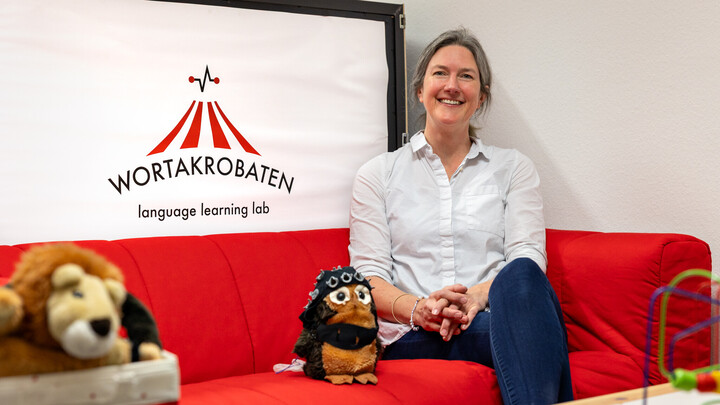Portrait of Prof. Dr. Nicole Altvater-Mackensen
Newborns already know remarkable things about language—long before they can speak. Psycholinguist Nicole Altvater-Mackensen explains how babies perceive language, what parents can learn from that, and why early language support matters.

When Professor Nicole Altvater-Mackensen talks about language, her eyes light up—not because of beautiful poetry or stirring speeches, but because of the sheer wonder of how early children begin to perceive, process, and understand language. In her “Word Acrobats” lab in square L15, she studies how babies and toddlers enter the world of words—long before they ever speak a word themselves.
The “Word Acrobats” lab, which Altvater-Mackensen now leads, looks more like a cozy playroom than a traditional research space: picture books, stuffed animals, toys—and a bright red couch, where the researcher sits comfortably. The space is designed to put the young participants—ranging from newborns to preschoolers—at ease. “You have to keep them motivated to take part. They get bored easily.”
Even in the womb, babies perceive intonation patterns and respond to speech melodies—as early as the second trimester, their hearing is already developed. After birth, they’re able to differentiate subtle sound contrasts, recognize their native language, and, within just a few months, start to pick up where words begin and end. “A newborn has already learned something about language before ever speaking a single word,” Altvater-Mackensen explains.
From the Netherlands to Mannheim
Her path to a professorship was anything but straight. She began with a passion for Romance studies—hardly the usual route into psycholinguistics. Her academic journey took her through linguistics, psychology, information science, and neuroscience, with stops in Nijmegen (Netherlands), Göttingen, Leipzig, and Mainz, before arriving in Mannheim, where she now holds the professorship for psycholinguistics. “I basically pieced my discipline together myself,” she says. At some point, she made the shift from theory to practice: “I wanted to understand how language works in the mind—and for that, you need empirical methods.”
At the heart of her work is the question of how the brain processes language. From early on, she was drawn to interdisciplinary perspectives. She was fascinated by how children learn language—and how deeply that learning is intertwined with cognitive and neural development.
But how do you measure language comprehension in children who can’t yet speak? In her lab, she uses methods like electroencephalography (EEG) and eye-tracking. For EEG experiments, she uses a soft cap, similar to a swim cap, fitted with electrodes to measure brain activity while the children are presented with specific stimuli. For example, they might hear the sentences “The boy is eating the cake” and “The boy sees the cake” while looking at a picture. The EEG data reveals how their brains respond to the target words. In eye-tracking experiments, children are shown images—say, a lion and a ball—while hearing words or sentences. The researchers then measure how quickly the child’s gaze shifts to the correct image when prompted with something like “Look, a ball!”
Language acquisition: Between myth and reality
Many assumptions about language acquisition persist—though not all hold up to scientific scrutiny. One of the most stubborn myths: that multilingualism overwhelms children. Not true, says Altvater-Mackensen: “Multilingual children aren’t confused—they have double the competence.” In fact, studies show that children can distinguish between languages remarkably well, even when they’re mixed in daily use. “They’re simply learning two linguistic systems at once at this young age—something adults often struggle with.”
She also challenges the widespread belief that girls are inherently better at language than boys. “Gender hasn’t been a significant factor in any of our studies. We see very individual differences, but no systematic patterns favoring one gender over the other.”
Another misconception concerns so-called “baby talk”—the exaggerated, sing-song way adults often speak to infants. While it might sound silly to outsiders, it’s actually developmentally beneficial. “When we talk to babies, we naturally adjust our speech: we speak more slowly, more clearly, with exaggerated intonation. That helps children recognize patterns and directs their attention to language,” Altvater-Mackensen explains. This adjusted speech, also known as infant-directed speech, is far from counterproductive—it actively supports language learning.
Despite her professional expertise, Altvater-Mackensen made a conscious decision not to observe her own children’s language development through a scientific lens. “I didn’t want to treat my kids like research subjects.” Still, they weren’t entirely untouched by her work. When she was developing new lab experiments, they often served as pilot testers in front of the eye tracker. During her time in Mainz, she even designed a prototype for wearable eye-tracking glasses to study children’s gaze behavior in more natural settings while being read to—her kids were the first to try them out.
Giving children access early
Even though Altvater-Mackensen’s work is considered basic research, it yields valuable insights for education and parenting—especially when it comes to the importance of early language exposure. The gap in language input between children can be massive: “up to 20 million words by the age of three.” And those differences have a profound impact on cognitive development. Talking to children supports far more than vocabulary—it helps shape how they think and learn. That much is clear in the “Word Acrobats” lab: language opens doors. The research doesn’t just help identify speech disorders early—it also shows that children understand the world much earlier and more deeply than adults often assume. Listening to them early on gives them more than just language—it gives them access. Because language is more than communication. It’s the key to education, identity, and community.
Text: Fabio Kratzmaier / August 2025
